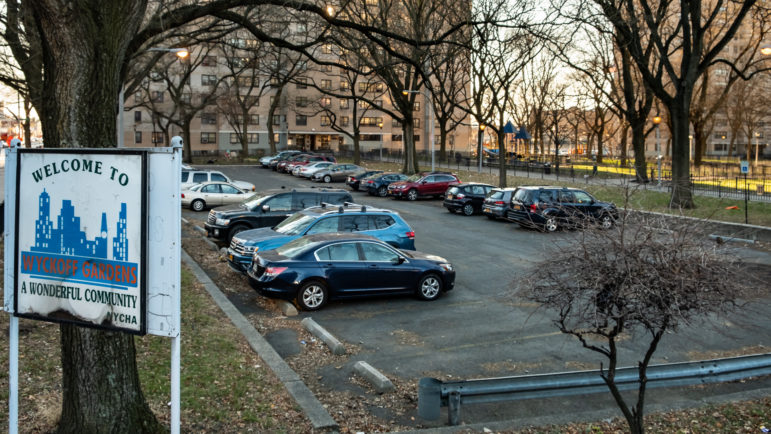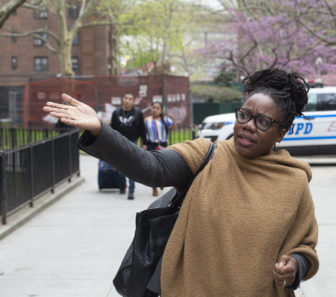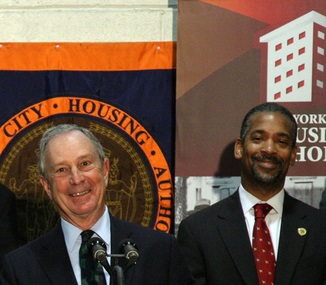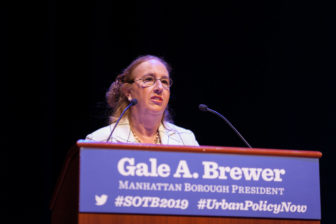
Adi Talwar
NYCHA tells City Limits that mixed-income projects are active at just three properties: Fulton Houses, Holmes Towers and Wyckoff Gardens.
On a recent Wednesday night at PS 33 in Chelsea, Gregory Russ, the new chairperson of the New York City Housing Authority stood in front of a cafeteria audience of NYCHA residents and attempted to explain the plan to fund repairs at the nearby Fulton and Chelsea-Elliot developments. “We want to preserve public housing in a neighborhood that it should be in,” he said.
“Chelsea is transforming.”
Indeed, glass high-rises surround the projects on 9th Avenue. Google’s New York City offices are adjacent. Townhouses on neighboring blocks start at roughly $5 million. But Fulton’s buildings, built between 1962 and 1965, need $214 million by 2027 to bring them to a state of good repair, according to a 2017 estimate. Add in the needs of the Chelsea-Elliot development and the to-do list costs over $317 million.
Lacking a source of federal funding and seeking to profit from the high rents that luxury housing would bring, NYCHA has proposed leasing a plot of land at Fulton houses for a new development, what many call infill development, but NYCHA calls NextGen. The proposal involves building a new high-rise in the place of two current low-rises, as well as a new building for the 72 NYCHA units that would be demolished.
NYCHA thinks the plan, which in this case, would also involve transferring management responsibilities to a private company, could fund repairs at both Chelsea developments.
There would seem to be some significant opportunity to build new housing to fund renovations at other developments too. NYCHA’s tower-in-the-park campuses include ample open space and often, also, parking lots and buildable land in high-rent areas is in short supply.
Projects like the one in Chelsea could make a small but significant dent in the $31.8 billion NYCHA says it needs by 2027. At the adjacent developments, it could bring fully renovated kitchens and bathrooms and non-leaky gas lines. New elevators, heating systems and better landscaped grounds could also be possible.
Since 2012, NYCHA has publicly considered infill development at at least 38 developments. The proposals vary but each involves building some new rentals. Some projects are a mix of market rate and ‘affordable’ apartments, while others are 100 percent affordable. Mostly, the market rate development proposals call for building on parking lots and the bulk of the locations that have been considered are in high rent areas like Chelsea. In total, NYCHA could accommodate more than 58 million square feet of new development, according to an analysis by the Citizens Budget Commission, an organization that supports infill, though it isn’t looking at developing anywhere close to that much.
Overall NYCHA has said it expects to raise $2 billion from its Build To Preserve program which encompasses infill development projects. It’s difficult to say if that number is realistic or not because it is unclear how many deals NYCHA intends to do, or what the unique revenue potential or each deal, shaped by multiple factors, from the number of affordable units and the levels of rent to the way financing is structured.
It is not even clear that the limited number of infill deals NYCHA has pursued will come to fruition.
Since announcing a revised infill plan as part of a turnaround plan last fall, NYCHA has narrowed its scope. A representative tells City Limits that projects at just three properties are still active: Fulton Houses, Holmes Towers and Wyckoff Gardens. Mayor Bill de Blasio’s original infill plan called for development on six sites, but the housing authority removed both Cooper Park in Williamsburg and Harborview Terrace in Hell’s Kitchen from consideration for infill this spring and there has been word on development at La Guardia Houses since an April meeting with tenants. It is listed as a site under consideration for development in NYCHA’s most recent annual filings.
Each ongoing project faces obstacles. Tenants and advocates have been vocal about their opposition to the Fulton Houses plan which NYCHA had hoped to move quickly with, calling out elected officials on social media and spurring the creation of a working group that has met regularly this fall. Until just last week, NYCHA faced a suit by Manhattan Borough President Gale Brewer which sought to require that all infill projects to go through the city’s Uniform Land Use Review Process (ULURP). Facing the lawsuit, NYCHA said it was abandoning its original plan for Holmes Towers this spring, and now plans to propose a revised project.
NYCHA hasn’t reached out to Wyckoff Gardens residents for many months, according to Shatia Strother, program coordinator at Families United for Racial and Economic Equality or FUREE, who has worked with Wyckoff Gardens tenants, but residents there were not supportive when a plan for their development was unveiled in early 2018.
“We’ve been down that road already. So far nothing. We’re fighting back. That’s all there is,” says Valerie Bell, president of the Wyckoff Gardens Resident Association.

Michael Appleton/Mayoral Photography Office
Mayor Bill de Blasio announces the city’s plan to renovate NYCHA apartments and preserve public housing in New York City at the NYCHA Hope Gardens Community Center in Brooklyn on Wednesday, December 12, 2018.
The case for infill
NYCHA’s fiscal predicament has been headline news for more than two years now. While management failures clearly contributed to the scandals around lead paint, mold, heat and hot water, a growing gap between resources and needs is the soil in which those scandals grew. With buildings dating to the 1930s, NYCHA faces increasing capital needs. In the early 2000s, support from the city, state and federal government declined rapidly. City Hall and Albany have been much more generous recently, but the delayed maintenance has only grown more expensive to address. This has led to doomsday assessments of the prospects for public housing’s future in the city. As the Regional Plan Association wrote last winter:
As is true of all buildings, NYCHA’s buildings need proper maintenance or they eventually become not just unsafe and unhealthy places to live, but legally uninhabitable. A building left to deteriorate long enough will eventually be in imminent danger of failure or collapse, rendering it unfit for human occupancy. While a timeframe for when this might happen for any specific building is unknown, what is certain is that if NYCHA continues on the current trajectory of endlessly deferred maintenance and compounding deterioration there will eventually be the need to evacuate significant portions of our public housing
While the $32 billion estimate of unmet capital needs is but an estimate—and one whose scope has so far eluded outside review—there’s no question NYCHA has deep needs. The administration’s plan hitches the authority’s salvation to a number of funding streams, including the conversion of tens of thousands of public housing units to Section 8 and the sale of air rights. But the $2 billion of capital funding (the precise time period over which that money would be received is not stated) is key.
“The number are there. That’s what they said they can generate,” says Councilmember Alicka Ampry-Samuel, who chairs the City Council’s committee on public housing, referring to the $2 billion in potential revenue from infill deals. “And when you look at the communities, you can see what they’re getting in development fees from other projects. Infill is what it is. We know the communities, we know the neighborhoods. We know the going rates and the costs of construction.”

William Alatriste for the NYC Council
Brooklyn Councilmember Alicka Ampry-Samuel
Ampry-Samuel believes that more value could actually be wrung out of the deals. “We give too many waivers to the developers. I think we can get more money,” she says. “We come off as a little desperate. The mayor has a lot of friends and we tend to make developers richer instead of starving them out.”
In addition to the revenue, infill development could add a significant number of units to the city’s rental market, where prices continue to climb. Most importantly, it could add rent-stabilized affordable units. “More housing stock is the only way to slow the overall growth of rents in the face of increased demand,” says Mark Willis, a senior policy fellow at NYU’s Furman Center, though he cautions that more stock may not decrease rents, just forestall growth.
“The first step is getting one of these deals closed—proving that the model works. The goal is right, it is just a matter of executing on it,” says Sean Campion, a senior research associate at Citizens Budget Commission.
That appears to be what NYCHA is trying to do at Fulton Houses, since none of its other projects are moving ahead at all.
A long argument
For as long as there’s been a NYCHA infill plan, there have also been tenants, advocates and elected officials advocating against it. Concerns are numerous and wide-ranging.
Though some infill proposals go back further, NYCHA’s first comprehensive infill plan became public less than a year before the end of Mayor Michael Bloomberg’s three-term tenure. It involved development at eight Manhattan campuses and would have constructed buildings where 20 percent of the units were “affordable.” It supposedly would have generated close to $37 million per year and allowed NYCHA to finance between $700 and $900 million in repairs at adjacent developments.
After the Bloomberg infill plan was announced, NYCHA conducted some resident outreach across the developments to mixed results. Six of the eight campuses where new construction was proposed were not supportive.

Mayor Bloomberg and John Rhea at a press conference in 2010. Rhea took the heat for maintenance problems and other woes at NYCHA.
Some tenants worried about being displaced from their NYCHA apartment, about the loss of open space and access to sunlight or about loss of parking spaces. Others worried about new high-income tenants that will gentrify the neighborhood or about construction noise and dust.
“First the parking lots. What’s next? Someone has to stop it. Where will the poor go?” said 40-year Smith Houses resident Antonia Florres in 2013.
“The one universal theme was that residents seemed to deeply feel that this was a threat to the continued existence of the developments as public housing,” says Fred Harris, NYCHA’s former chief of real estate and development, who led the original push for infill under Bloomberg.
“There was a complete lack of trust.”
RFPs were due in December 2013 but by that fall, opposition was already significant. In October 2013, the City Council moved in court to stall the leasing of land at NYCHA—a suit intended to stall any deals until the new mayor took office. Advocates filed a similar suit. Then-candidate de Blasio voiced his objection, too. When he arrived in City Hall, de Blasio abandoned the work that had been done before him, distancing himself from the original proposal and ignoring the RFPs that had been submitted.
As NYCHA’s budget crisis continued to worsen, however, the new mayor announced Next Generation NYCHA in 2015—and it included a new infill scheme that planned work at an entirely new set of campuses. It also called for only 50 percent of the new units to be market-rate as opposed to the Bloomberg administration’s 80. That shift was a double-edged sword: lowering the potential revenue the deals could raise, while increasing the affordability benefit of the deal—perhaps with an eye toward softening anticipated opposition.
Concerns remained. But plans for some deals like Wyckoff Gardens and Holmes Towers moved forward and developers were selected, though there was scrutiny of the fact that some were major de Blasio campaign donors.
The affordability splits were revised again in 2018 to require 30 percent of units be affordable and, unsurprisingly, pushback has continued.
Anatomy of an argument
In some sense, it is understandable. Who wouldn’t push back against a plan that would put a large new building in your backyard?
“Infilling NYCHA with new structures will not only take away some of the city’s last open spaces, and tree canopy, but will further undermine the remaining quality of life for current NYCHA residents. Less air flow, fewer trees, and reduction in permeable surfaces seems like a bad idea for a warming city,” Nicholas Dagen Bloom, professor of urban policy, wrote recently.
“I’m against it now. I was for it in the beginning, but what would it cost us—we would be boxed in, these buildings would cut off air,” says Wyckoff Gardens resident Paula Smith.
A profound lack of trust colors some residents’ reaction to the plan.

Office of the Manhattan Beep
Gale Brewer, Manhattan borough president, has faulted the way NYCHA engages communities.
“If they’re going to do what they’re supposed to do with the money, I’m for it,” says Beverly Corbin, a Wyckoff Gardens resident, referring to the renovations of her apartment building that would come with infill. “If they’re just going to play a game, no,” she adds.
Some also see the leasing of NYCHA land for private development that will be privately managed as a step toward privatizing public housing.
However, perhaps the most common theme throughout the infill development attempts, and one especially voiced by elected officials and advocates supporting residents, is that NYCHA does not construct the plans with tenant input and does a poor job of communicating along the way.
This is the concern behind Manhattan Borough President Gale Brewer’s legal fight against a proposed building to be constructed at the Holmes Towers on the Upper East Side, where she has been suing to require public review. A bill to require this procedure is currently pending in the state legislature.
Others, even those supportive of a plan, agree. “They don’t go in to make decisions together, they go in to share the plan that they have cooked,” says Rachel Fee, executive director of the New York Housing Conference, who also says that broadly, infill is an opportunity for NYCHA. “There are a lot of ways you can include residents either in input into the scope of work or what new amenities on the site.”
It can be done
Despite all the community and political pushback to these higher profile infill deals, construction of new buildings on NYCHA campuses has and continues to be done, just not for market-rate tenants.
A review of annual filings and reports for the past five years indicates infill projects are in the works or have been completed at at least 12 developments since 2017. A 100 percent affordable development at Van Dyke Houses in Brownsville was completed in 2017. Another infill project was just announced this November. Projects at Soundview Houses, Linden Houses and Ingersoll houses have also been constructed.
When NYCHA infill was pitched several years ago, it moved too fast, says Fred Harris, who still believes strongly in the promise. “If I did it again, I would have followed the advice of people who were saying, stop trying to do so much. I felt like we needed to do 10,000 apartments but looking back, it would be smart to have done it more conventionally. We should have taken a first-floor apartment, apartment, upgraded it and shown the residents around.”
But time is of the essence too. “One of the important things about NYCHA is to fix it before it would cost as much to fix as replace,” says Harris.
Every year that repairs don’t get made, the cost to complete them increases. NYCHA’s estimate of physical needs within five years went from $16.5 billion in 2011 to $31.8 billion in 2017. “That context should lend some urgency to stakeholders at every level to move forward with a plan that is responsive to resident concerns and provides desperately-needed funds for repairs,” says Charles McNally, director of external relations at NYU’s Furman Center.
Constructing new affordable units is quite expensive but “preserving NYCHA is still the cheapest housing date in town,” Harris added.
Whether infill can contribute to this goal it might come down to how NYCHA can deal with residents’ concerns. The central questions, according to Ampry-Samuel, are, “How do you include the residents in development? How do you get them to have trust? That’s by building the building for them. How about you build the new building and then move them into the new construction? Make them a part of the process. If you’re going to include them in the design process, their design and input should be included in the RFP.”

The Van Dyke Houses, Brooklyn.
A chance in Chelsea
The process at Fulton Houses might be this—it provided a genuine forum for residents to air concerns and speak with NYCHA leadership—but it also bears some marks of being a strategy to make residents feel heard and simply convince them that NYCHA’s plan is the right plan.
At the recent Chelsea resident engagement session, one resident voiced a concern about the threat of displacement. A NYCHA community outreach staff member attempted to address it, explaining that she would retain all rights she currently has. Another tenant was concerned about secession rights: She wanted to preserve the ability to transfer the lease to the apartment to her child if she moved to Georgia. Same response from NYCHA.
“They want to engage in rigorous conversation about what they think. They want to feel like they’re being heard,” says spokesperson Barbara Brancaccio. “The reality is that it is much better to have conversations with other residents, community members people who are working on this. That’s how people form their opinions, that’s how minds are changed.”
Even with a truly inclusive process, though, it might be that NYCHA can’t make all residents feel comfortable. Sasys one resident who asked not to be identified. “All change is bad.”









2 thoughts on “NYCHA Development Dreams at a Crossroads”
Maybe people living in public housing should humbly stop trying to run things and stop trying to decide on multimillion dollar real estate deals as if they own land and condos. They are just paralyzing any progress and letting these city buildings get to the breaking point. If people can’t even run their own finances and need public assistance for their personal housing then they have no business acting like accountants and developers. Stop pretending to know everything.
More effective policies are needed to achieve sustainable development